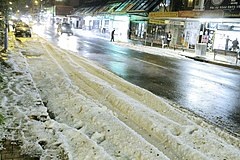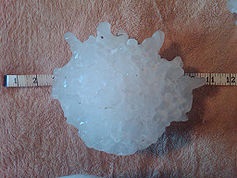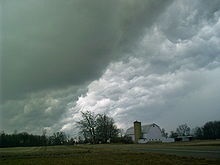|
|
| |
|
|
| |
|
|
|
|
| |
 |
| Accumulated hail in
Sydney, Australia (April 2015). |
Hail
Hail is a form of solid precipitation. It is distinct
from ice pellets (American English "sleet"), though the
two are often confused. It consists of balls or
irregular lumps of ice, each of which is called a
hailstone. Ice pellets fall generally in cold weather
while hail growth is greatly inhibited during cold
surface temperatures.
Unlike other forms of water ice such as graupel, which
is made of rime, and ice pellets, which are smaller and
translucent, hailstones usually measure between 5 mm
(0.2 in) and 15 cm (6 in) in diameter. The METAR
reporting code for hail 5 mm (0.20 in) or greater is GR,
while smaller hailstones and graupel are coded GS.
Hail is possible within most thunderstorms as it is
produced by cumulonimbus, and within 2 nmi (3.7 km) of
the parent storm. Hail formation requires environments
of strong, upward motion of air with the parent
thunderstorm (similar to tornadoes) and lowered heights
of the freezing level. In the mid-latitudes, hail forms
near the interiors of continents, while in the tropics,
it tends to be confined to high elevations.
There are methods available to detect hail-producing
thunderstorms using weather satellites and weather radar
imagery. Hailstones generally fall at higher speeds as
they grow in size, though complicating factors such as
melting, friction with air, wind, and interaction with
rain and other hailstones can slow their descent through
Earth's atmosphere. Severe weather warnings are issued
for hail when the stones reach a damaging size, as it
can cause serious damage to human-made structures and,
most commonly, farmers' crops. |
|
 |
| The largest recorded
hailstone in the United States. |
Definition
Any thunderstorm which produces hail that reaches the
ground is known as a hailstorm. Hail has a diameter of 5
millimetres (0.20 in) or more. Hailstones can grow to 15
centimetres (6 in) and weigh more than 0.5 kilograms
(1.1 lb).
Unlike ice pellets, hailstones are layered and can be
irregular and clumped together.[citation needed] Hail is
composed of transparent ice or alternating layers of
transparent and translucent ice at least 1 millimetre
(0.039 in) thick, which are deposited upon the hailstone
as it travels through the cloud, suspended aloft by air
with strong upward motion until its weight overcomes the
updraft and falls to the ground. Although the diameter
of hail is varied, in the United States, the average
observation of damaging hail is between 2.5 cm (1 in)
and golf ball-sized (1.75 in).
Stones larger than 2 cm (0.80 in) are usually considered
large enough to cause damage. The Meteorological Service
of Canada issues severe thunderstorm warnings when hail
that size or above is expected. The US National Weather
Service has a 2.5 cm (1 in) or greater in diameter
threshold, effective January 2010, an increase over the
previous threshold of ¾-inch hail. Other countries have
different thresholds according to local sensitivity to
hail; for instance grape growing areas could be
adversely impacted by smaller hailstones. Hailstones can
be very large or very small, depending on how strong the
updraft is: weaker hailstorms produce smaller hailstones
than stronger hailstorms (such as supercells). |
|
 |
| Severe thunderstorms
containing hail can exhibit a characteristic
green coloration. |
Formation
Hail forms in strong thunderstorm clouds, particularly
those with intense updrafts, high liquid water content,
great vertical extent, large water droplets, and where a
good portion of the cloud layer is below freezing 0 °C
(32 °F). These types of strong updrafts can also
indicate the presence of a tornado. The growth rate of
hailstones is impacted by factors such as higher
elevation, lower freezing zones, and wind shear.
Layer nature of the
hailstones
Like other precipitation in cumulonimbus clouds, hail
begins as water droplets. As the droplets rise and the
temperature goes below freezing, they become supercooled
water and will freeze on contact with condensation
nuclei. A cross-section through a large hailstone shows
an onion-like structure. This means the hailstone is
made of thick and translucent layers, alternating with
layers that are thin, white and opaque. Former theory
suggested that hailstones were subjected to multiple
descents and ascents, falling into a zone of humidity
and refreezing as they were uplifted. This up and down
motion was thought to be responsible for the successive
layers of the hailstone. New research, based on theory
as well as field study, has shown this is not
necessarily true.
The storm's updraft, with upwardly directed wind speeds
as high as 110 miles per hour (180 km/h), blows the
forming hailstones up the cloud. As the hailstone
ascends it passes into areas of the cloud where the
concentration of humidity and supercooled water droplets
varies. The hailstone's growth rate changes depending on
the variation in humidity and supercooled water droplets
that it encounters. The accretion rate of these water
droplets is another factor in the hailstone's growth.
When the hailstone moves into an area with a high
concentration of water droplets, it captures the latter
and acquires a translucent layer. Should the hailstone
move into an area where mostly water vapor is available,
it acquires a layer of opaque white ice. |
|
 |
| Early automobiles
were not equipped to deal with hail. |
Hazards
Hail can cause serious damage, notably to automobiles,
aircraft, skylights, glass-roofed structures, livestock,
and most commonly, crops. Hail damage to roofs often
goes unnoticed until further structural damage is seen,
such as leaks or cracks. It is hardest to recognize hail
damage on shingled roofs and flat roofs, but all roofs
have their own hail damage detection problems.[43] Metal
roofs are fairly resistant to hail damage, but may
accumulate cosmetic damage in the form of dents and
damaged coatings.
Hail is one of the most significant thunderstorm hazards
to aircraft. When hailstones exceed 0.5 inches (13 mm)
in diameter, planes can be seriously damaged within
seconds. The hailstones accumulating on the ground can
also be hazardous to landing aircraft. Hail is also a
common nuisance to drivers of automobiles, severely
denting the vehicle and cracking or even shattering
windshields and windows. Wheat, corn, soybeans, and
tobacco are the most sensitive crops to hail damage.
Hail is one of Canada's most expensive hazards.
Rarely, massive hailstones have been known to cause
concussions or fatal head trauma. Hailstorms have been
the cause of costly and deadly events throughout
history. One of the earliest known incidents occurred
around the 9th century in Roopkund, Uttarakhand, India,
where 200 to 600 nomads seem to have died of injuries
from hail the size of cricket balls. |
|
 Kiddle: Hail Kiddle: Hail
Wikipedia: Hail |
|
|
|
|
|
|
|
|
|
|
|
|
|
|
|
|
Search Fun Easy English |
|
|
|
|
|
|
|
|
|
|
|
|
|
|
|
About
Contact
Copyright
Resources
Site Map |